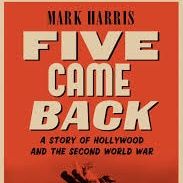Mark Harris Five Came Back
Feb 24, 2015 ·
16m 2s

Download and listen anywhere
Download your favorite episodes and enjoy them, wherever you are! Sign up or log in now to access offline listening.
Description
No industry professionals played a bigger role than five of America’s most celebrated directors: • John Ford joined the Navy, filmed the battle of Midway and was also present at...
show more
No industry professionals played a bigger role than five of America’s most celebrated directors:
• John Ford joined the Navy, filmed the battle of Midway and was also present at Normandy right around D-Day. His documentary “The Battle of Midway” is the war’s first great chronicle of a battle.
• William Wyler—the only Jewish man of the five—joined the Army Air Force, a decision that resulted in one of the great documentaries about a squadron of fighting men, “The Memphis Belle,” and also in his hearing loss. He used all of his war experiences to make a definitive masterpiece about the war’s aftermath, “The Best Years of Our Lives.”
• John Huston made two important documentaries during the war, “Report from the Aleutians” and the largely faked “Battle of San Pietro,” and one right after the war, “Let There Be Light,” about mentally ill veterans in an army hospital.
• George Stevens was present in the North African campaign, the liberation of Paris, and the Battle of the Bulge. He led the first American cameras into Dachau, and what he filmed there became crucial evidence at Nuremberg. More than any of the five, he was emotionally shattered by the war, although he went on to extraordinary accomplishment.
• Frank Capra stayed largely in Washington, D.C., where he ran the Army’s filmed propaganda efforts, and oversaw dozens of newsreels, cartoons, intelligence reports and documentaries for both public and military use, most famously the seven “Why We Fight” films, which became mandatory viewing for all GIs.
As it did for so many others, World War II divided the lives of these men. In FIVE CAME BACK, Mark Harris brilliantly reckons with that transformation on a human level, on the level of the larger Hollywood industry, and the country as a whole.
Follow Mark on Twitter: @MarkHarrisNYC
show less
• John Ford joined the Navy, filmed the battle of Midway and was also present at Normandy right around D-Day. His documentary “The Battle of Midway” is the war’s first great chronicle of a battle.
• William Wyler—the only Jewish man of the five—joined the Army Air Force, a decision that resulted in one of the great documentaries about a squadron of fighting men, “The Memphis Belle,” and also in his hearing loss. He used all of his war experiences to make a definitive masterpiece about the war’s aftermath, “The Best Years of Our Lives.”
• John Huston made two important documentaries during the war, “Report from the Aleutians” and the largely faked “Battle of San Pietro,” and one right after the war, “Let There Be Light,” about mentally ill veterans in an army hospital.
• George Stevens was present in the North African campaign, the liberation of Paris, and the Battle of the Bulge. He led the first American cameras into Dachau, and what he filmed there became crucial evidence at Nuremberg. More than any of the five, he was emotionally shattered by the war, although he went on to extraordinary accomplishment.
• Frank Capra stayed largely in Washington, D.C., where he ran the Army’s filmed propaganda efforts, and oversaw dozens of newsreels, cartoons, intelligence reports and documentaries for both public and military use, most famously the seven “Why We Fight” films, which became mandatory viewing for all GIs.
As it did for so many others, World War II divided the lives of these men. In FIVE CAME BACK, Mark Harris brilliantly reckons with that transformation on a human level, on the level of the larger Hollywood industry, and the country as a whole.
Follow Mark on Twitter: @MarkHarrisNYC
Information
| Author | Arroe Collins |
| Organization | Arroe Collins |
| Website | - |
| Tags |
Copyright 2024 - Spreaker Inc. an iHeartMedia Company
